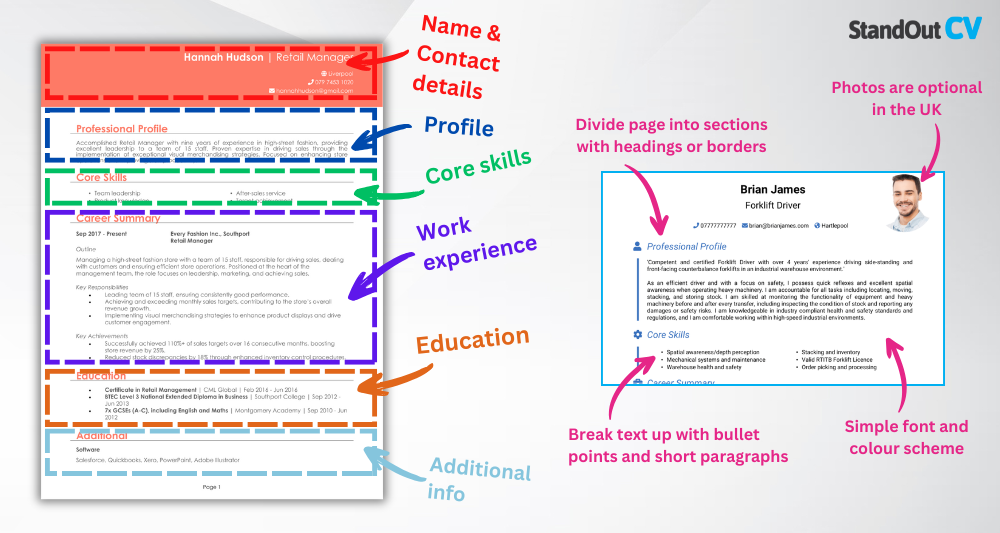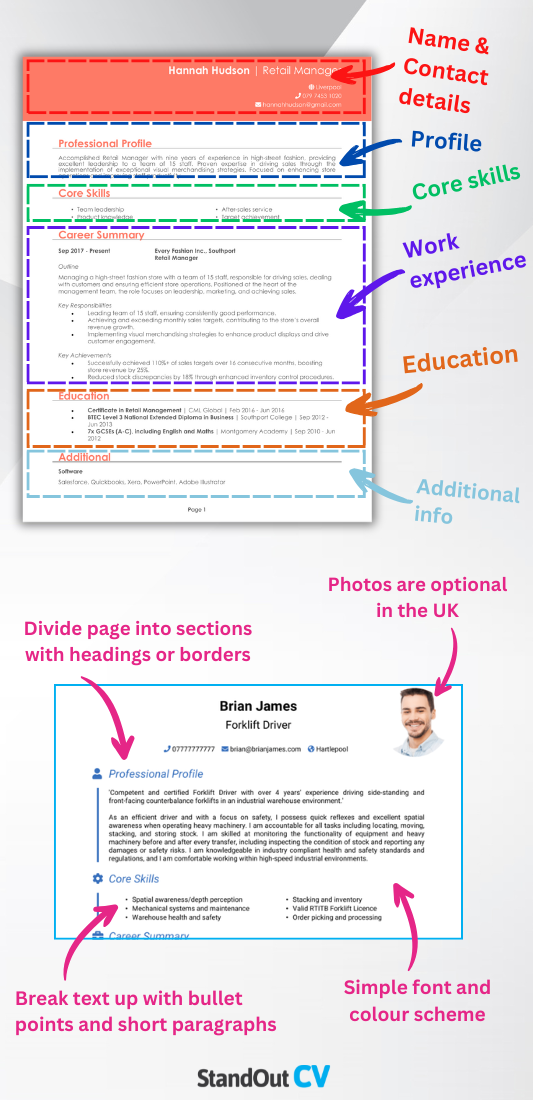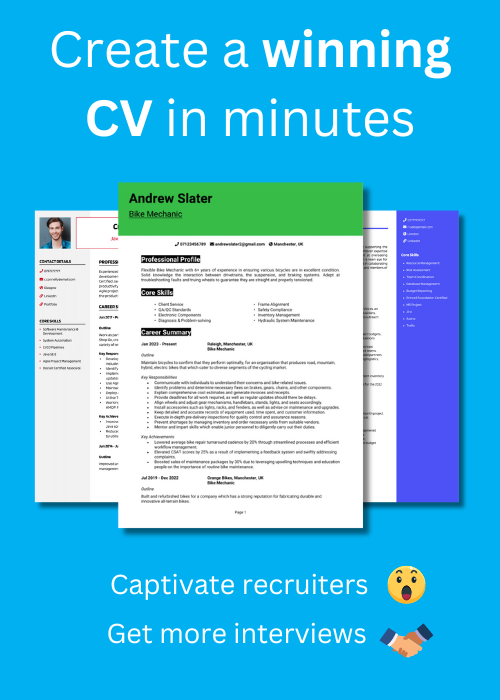If you’re looking for your next kitchen job, your CV needs to show you’ve got just as much control on paper as you do on the line.
A good cook doesn’t just follow recipes – they keep the kitchen moving and know how to plate up excellence, even when the heat is on.
This guide, along with its Cook CV example and clear advice, will help you lay out your experience in a way that’s recruiter-ready.
Cook CV sample

How to write your Cook CV
Discover how to craft a winning Cook CV that lands interviews with this simple step-by-step guide.
If you want your next role to recognise your skills, your CV needs to serve up more than a job list.
This guide will walk you through writing a CV which describes your experience in a way that resonates with employers and showcases your strengths.
Cook CV format and structure guidelines


In a professional kitchen, everything has its place – and the same applies to your CV structure. If your experience and skills are poorly presented, or just full of avoidable visual mistakes, a hiring manager won’t stick around to find out what you can do. You’ll need to guide them effortlessly through your application.
Here’s the layout to follow:
- Name and contact details – These personal details sit at the top to provide easy access for prospective employers.
- Profile – Hook the recruiter right away by stating the value you’ll bring to their company.
- Core skills – State your best qualities at a quick glance.
- Work experience – List your previous job titles from newest to oldest.
- Education – Show off your academic record and qualifications.
- Additional info – Include anything from your hobbies and interests to the languages you speak – these are all totally optional.
Use clear section headings to break up the content, a simple readable font to keep things professional, and bullet points throughout each section to break up blocks of text. Stick to a two-page maximum length, and leave enough space between sections to make scanning easy. A cluttered CV format can be just as off-putting as a cluttered kitchen – so keep it sharp and well laid out.
Creating a strong Cook profile


Your CV profile is your first opportunity to give the recruiter a flavour of what you bring to the kitchen – so make it count. This short paragraph should outline the environments you’ve worked in and your strongest cooking-related skills.
You might be working in a fast-paced pub, a school canteen, or a five-star hotel – whatever the setting, your profile should convey your ability to handle pressure and maintain food safety. Recruiters should quickly understand why you’re a suitable choice for the role.
Cook CV profile examples
Profile 1
Experienced Cook with over ten years of experience in high-volume restaurant and pub kitchens. Skilled in preparing fresh, seasonal dishes, managing kitchen stations, and maintaining food hygiene standards. Comfortable working under pressure and delivering consistent quality in fast-paced environments.
Profile 2
Hardworking Cook with seven years of experience in school catering and care home settings. Adept at preparing nutritious meals tailored to dietary needs and overseeing meal services for large groups. Committed to food safety and efficient kitchen operations.
Profile 3
Reliable Cook with five years of experience in casual dining and takeaway restaurants. Proficient in batch cooking, managing prep areas, and supporting chefs during busy service. Holds a Level 2 Food Safety Certificate and known for punctuality and teamwork.
Details to put in your Cook CV profile
Make sure to cover the following:
- Where you worked – Cafés, pubs, schools, restaurants, care homes, hotels
- Your top qualifications – Food hygiene certificates, NVQs in Catering, or chef training
- Essential skills – Food prep, portioning, time management, following dietary needs
- Types of meals or cuisine – Bulk prep, carvery, à la carte, buffets, ethnic cuisines
- Kitchen environment – Solo cook, small team, or large kitchen with brigade structure
Show off the core skills recruiters look for


This part should summarise the practical skills and kitchen experience you bring to the table in a short list of bullet points.
The best part? You can easily tailor your CV skills to different roles: a useful tip is to scan over the job spec to inform you precisely what keywords the employer will be looking for in an application. Focus on those tangible, hard skills which are really valued in the kitchen.
Most important skills for a Cook
- Food Preparation and Cooking Techniques – Preparing ingredients and using a range of cooking methods such as grilling, baking, frying, and steaming.
- Recipe Following and Portion Control – Accurately following recipes and ensuring consistent portion sizes for quality and cost control.
- Knife Skills and Ingredient Handling – Safely and efficiently chopping, slicing, and preparing ingredients for a variety of dishes.
- Kitchen Equipment Operation – Using ovens, grills, fryers, and mixers correctly and maintaining them in good working condition.
- Food Safety and Hygiene Compliance – Adhering to hygiene standards and regulations, including proper food storage and cross-contamination prevention.
- Stock Rotation and Waste Minimisation – Managing inventory by rotating stock and using ingredients efficiently to reduce waste.
- Plating and Presentation – Assembling dishes attractively and consistently to meet visual and quality standards.
- Menu Knowledge and Adaptability – Understanding menu items thoroughly and adjusting dishes to accommodate dietary needs or allergies.
- Time Management and Multitasking – Preparing multiple dishes simultaneously under time pressure in a fast-paced kitchen environment.
- Team Communication and Coordination – Collaborating with kitchen staff to ensure smooth service and consistent food quality.
Describing your work experience


The work experience section is where you show how your skills translate into real results – not just cooking, but supporting the kitchen team and making sure food is served correctly and on time.
Go over your past jobs starting with your most recent. For each role, begin with a short overview of where you worked and the type of food service, followed by bullet points breaking down your responsibilities and any key achievements. If you’ve worked outside of professional kitchens (e.g. in volunteer food services or private events), these can still be included, especially if you’re early in your career.
What’s the correct way to structure job history on your CV?

- Outline – Give context: what kind of kitchen did you work in, what was the menu like, and who did you report to?
- Responsibilities – Use action words like “prepared” and “maintained.” For example: “prepared and plated 80+ lunches daily in a care home kitchen” or “maintained clean prep areas and followed strict food hygiene regulations.” Mention shifts, teamwork, and specific duties.
- Achievements – Include anything that proves your value – positive hygiene inspections, helping reduce food waste, or improving prep times. Add numbers or details where you can.
Sample work experience for Cooks
Cook | Birchfield Arms Pub
Outline
Prepared and served meals in a busy pub kitchen, working as part of a team delivering a varied menu of classic British dishes and seasonal specials.
Responsibilities
- Cooked meals to order across grill, fryer, and prep stations
- Maintained cleanliness and organisation of kitchen work areas
- Followed portion control guidelines and food safety standards
- Assisted with weekly stock checks and food deliveries
- Supported kitchen team during peak service periods and events
Achievements
- Helped reduce food waste by 18% through improved portion prep and rotation
- Recognised by head chef for reliability and ability to manage multiple stations
- Contributed to pub maintaining 5-star food hygiene rating across inspections
Cook | Havenbrook Residential Care
Outline
Prepared daily meals and snacks for up to 50 residents in a care home setting, ensuring nutritional needs and dietary restrictions were carefully followed.
Responsibilities
- Planned and cooked breakfast, lunch, and evening meals to weekly menus
- Prepared modified texture meals for residents with swallowing difficulties
- Ensured compliance with allergen policies and health standards
- Maintained records of food temperatures and fridge logs
- Worked with care staff to adjust meal plans based on resident feedback
Achievements
- Consistently praised by residents and families for meal quality and variety
- Passed all internal and external food safety audits with full compliance
- Introduced new low-sugar dessert options, improving diabetic meal choices
Line Cook | Slice Station Ltd
Outline
Worked in a high-volume pizza takeaway restaurant preparing ingredients and cooking orders during peak service hours.
Responsibilities
- Prepared dough, sauces, and toppings ahead of daily service
- Cooked pizzas using stone ovens and ensured quality consistency
- Packaged takeaway orders and coordinated with delivery team
- Cleaned workstations and handled end-of-shift breakdown and prep
- Followed hygiene practices and maintained temperature logs
Achievements
- Managed up to 80 orders per shift during peak weekend hours
- Trained two junior staff in kitchen routines and hygiene practices
- Reduced prep time by 15% through reorganised ingredient layout
What should your CV’s education section include?


This section should list your food-related qualifications and any formal education you’ve completed. List them in reverse chronological order, starting with the most recent.
You can also mention general education qualifications if you’re early in your career, or note if you’re working towards a professional cookery qualification, but try to keep the section brief, as your experience is what really matters the most.
What qualifications do employers look for in a Cook?
- Level 2 Food Safety and Hygiene Certificate – Required for working in any food prep environment
- NVQ Level 2 in Professional Cookery or Catering & Hospitality – Practical foundation for all kitchen roles
- BTEC in Hospitality or Catering – Covers customer service as well as food prep
- Allergen Awareness Certificate – Vital for kitchens handling special dietary needs
- Level 3 Supervising Food Safety – Suitable for those in charge of food storage or other cooks





